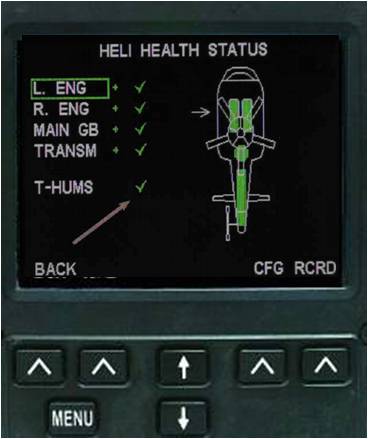T-HUMS: System Description
The T-HUMS is RSL's proven family of Vibration Monitoring and Health & Usage management solution for helicopters and UAV's. The system which have accumulated over a hundred thousand of flight hours on-board different platforms has been qualified as standard equipment by the Israeli Air Force and has also been certified by the Russian civil aviation authority (IAC- ARMAK) in collaboration with Russian Helicopters.
The T-HUMS significantly enhances flight safety, mission readiness and fleet availability, as well as reducing the life cycle costs of the monitored platform.
These benefits are achieved by monitoring and performing in-flight diagnostics of all critical components within the airborne platform in order to determine their health and usage, providing the helicopter air-crew/UAV operator with real-time health status and the fleet maintainers with accurate and reliable usage status in addition to the health alarms, enabling cost-effective maintenance while keeping the fleet in optimal condition.
RSL's T-HUMS features a powerful processing unit providing the unique capability to perform real-time in-flight diagnostics of more than 300 rotating drive-train components, immediate flight-regime recognition, detection of over-limits as well as Rotor Track and Balancing (RT&B) instructions.
In order to reduce turn-around time between missions the system is capable of quick downloading of relevant data including alerts, indicators and trends which are required to indicate the platform's readiness for the next sortie as part of the flight-line turn-around procedures, in addition to the downloading of raw data which can be used for further non flight-line in-depth analysis.
This capability is supported by a scalable remote access, web-based, usage & fleet management ground element of the system providing full visibility of usage & health data at all levels, starting with a specific tail number through the squadron/wing level, and up to base and headquarters levels.
Apart from the Usage & Fleet management, the ground element of the T-HUMS provides the operator with full independent diagnostic analysis capability without the need to resort to external diagnostics services of the HUMS manufacturer.
The T-HUMS architecture is unique in the sense that the analytical diagnostic process can take place either in-flight within the on-board system, or alternatively on the ground within the ground station. The T-HUMS also includes optional flight data recording, video and voice recording for post mission debriefing as well as optional crash survivable memory module.
The diagnostic core of the T-HUMS, which is currently installed on board AH-64, CH-53 and Mil-17 helicopters is easily adaptable to other types of helicopters and also to UAVs.
Main Features:
Airborne Segment
Functions:
The on-board equipment provides:
- Continuous in-flight diagnostics of the helicopter’s drive train components
- Automatic flight regime recognition for platforms diagnostics
- In flight monitoring of exceedances and over-limits
- In flight display alerts and diagnostics results
- Flight data and vibrations recording and processing
- Data acquisition for Rotor Tracking and Balancing (RT&B)
- Automatic RT&B data analysis, storage and display to the crew
- Registration of life usage indicators for helicopter and engines
- Engine power control checks
- Helicopter performance tests
- Helicopter mission configuration storage and display
- Display T-HUMS health status using the built-in test module
Ground Segment
The Integrated Flight Line Station provides:
- Display of helicopter health status & diagnostics
- Display of over-limits and life usage indicators
- Perform Rotor Tracking and Balancing (RT&B)
- Display of flight data and vibration recordings.
- Helicopter maintenance information storage and display.
- Configuration and testing of the on-board T-HUMS equipment.
The main modules of the Ground Station are as follows:
- Fleet management module:
- Health status monitoring
- Mission readiness review
- Access to flight statistics
- Access to failure statistics
- Differentiation according to operators and helicopter types
- Helicopter condition management module:
- Flight data and vibrations analysis
- Trending of helicopter condition indicators
- Alert history display
- Maintenance actions history
- Life usage indicators display
- Helicopter maintenance management
- Flight operation quality control module:
- Analysis of flight data recordings
- Over-limit analysis
- Database management module:
- Data archiving
- Access management
- System configuration
- Report generation module









